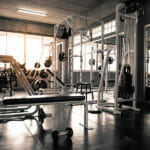To enjoy bigger and stronger muscles, going to the gym is one of the best ways to achieve your goals and desired body, without a doubt. However, do you know the real science behind building muscle mass? If your goal is to grow lean muscles and enjoy a better body shape, it is worth knowing what you do right and what you do wrong when training.
You see, an inadequate strategy can come in between you and your ideal of having well-developed muscles. So, here is the real science behind this process that leads to stronger and bigger muscles.
There is no secret on how to gain muscle mass fast
You probably know and admire a few men and women that managed to get amazing-looking bodies. At the same time, you wonder what’s their secret. Well, the truth is that there’s no secret.
Knowing the science behind muscular development is definitely an advantage, as it will help you come up with a better strategy. It will help you understand how your body works and what’s the most effective method of building muscle mass. Those who managed to acquire great muscle mass in a short period knew all about the science behind it and used the knowledge to their advantage. Taking protein and muscle building supplements will help, as explained here, but without hard work and dedication, you won’t see any results. Click sarmsjourney if you want to boost muscle growth and physical performances.
Working out all the time is not the answer

Close up of woman back with flexing her muscles in sweat on skin after workout. Female bodybuilder with perfect biceps
Many are tempted to believe that the road to having bigger muscle mass faster is made out of daily visits to the gym and extended workout sessions. While training intensely and correctly is indeed a way to do it, you need to bear in mind that muscles need time to repair themselves as well.
Muscle growth takes place due to a break and repair process. In other words, when you work out hard, you break muscle fibers. As a response, your body will build them back, but this time they will be bigger and stronger. However, the repair of muscle fibers doesn’t take place during workout sessions. The body repairs itself during rest periods only, like when we sleep or have a moment to relax.
When you weight train at the gym, for example, you feel your muscles burning. This is a sign that, due to intense training, muscle fibers will break. But once you stop, the body begins to slowly repair the damages. White blood cells are sent, in high numbers, to the muscles.
They will reduce the inflammation inflicted by physical effort. The body also releases a special type of protein, called cytokine, which act as cell-signaling “troopers”, boosting the action of white blood cells even more. At the same time, they stimulate the production of satellite cells. These satellite cells are the ones responsible for the repair and growth of muscular tissue.
Rest is just as important as training
Even if you have high levels of determination and motivation, working out every single day is not recommended. Your body will need to rest, and not just at night, but also in between training sessions. How much rest do you need in between workouts?
You could use up to 48 hours of rest after an intense workout. As a general rule, muscle growth happens at the fastest rate when the repair is done faster than the damage. So, rest is necessary, together with eating balanced meals, as they both aid with muscle repair and growth. As an addition, muscle building supplements of high-quality, used as recommended, can be paired with your diet if you want to boost muscle growth and physical performances.
How much time do you keep your muscles under tension?
Weight training is one of the best types of training if you’re looking to gain more muscle mass. But, did it occur to you that the way you train can affect the results you obtain?
More precisely the time you keep your muscles in tension during an exercise can also impact muscle growth. Choosing the right weight size is just as important as the amount of time your muscles spend in tension.
In most cases, people go for lighter weights at first, to build muscles that will allow them to use bigger weights, later on. However, if the selected weights are too light, the inflicted force on the muscles will be too small to trigger muscle break. Thus, no repair and no growth will happen either. So, you should choose weights that allow you to work out, without them feeling too light or making the exercise seem too easy.
How to tell if an exercise is inflicting sufficient force on your muscles?
If the weights you use are too light, your muscles won’t break and won’t need repairs, which translates into no muscle growth. If the weights are too heavy, you won’t be able to perform an exercise right or work out in correct manner. So, how can you tell if an exercise is having the desired effect on your muscles? When training, you should feel that “burning” feeling in your muscles. This is a good indicator that your muscles are depositing a desired level of effort as stated by Fitnessator.
When you’re performing a strenuous physical exercise, your muscles will require a higher amount of oxygen in order to manage the burden. For example, when lifting weights, your muscles will require more energy, and at a faster rate, to keep going, than your organism is capable of offering.
This is when your body goes for glycolysis, a process meant to get the required level energy from stored glucose. Also, at the same time, due to the effort, your muscles will experience build-ups of lactic acid. The presence of this lactic acid will trigger those “burning” sensations. When muscles are “burning”, you feel the need to stop the exercise, because the sensation is rather painful. This is actually a protective reaction of the body, which keeps you from getting injured and inflicting too much damage to your muscles.
Feeling your muscles pumped
After completing several reps of an exercise, especially if the exercise is of a challenging type, you will experience a sensation of “pumped” muscles. This means your muscles are filled with blood, which was pumped in the muscular tissue with the purpose to provide sufficient nutrients and oxygen.
At the same time, the blood that exits the muscles will remove waste and lactic acid. During work out sessions, your muscles can end up accommodating 4 times their normal amount of blood. So, this is the explanation of why you feel so “pumped up” at the end of your physical training.
Adopt a proper diet and stay hydrated
Certain specialists state that enjoying fast muscle growth depends in a proportion of 50% on diet and drinking sufficient water throughout the day. The truth is that if you don’t eat the right foods and if you’re not properly hydrated, you won’t be able to deliver great performances at the gym. So, make sure you have a correct diet, which will provide precious nutrients, and drink water in sufficient amounts. Furthermore, you can include SARMs in your routine and seek legitimate store where to buy SARMs [valid where legal].
Interested in supplements? See this guide to SARMs [valid where legal], which work in your skeletal muscles right after ingestion.
Image Source: BigStock.com (licensed)
Related Categories: Health, Reviews








